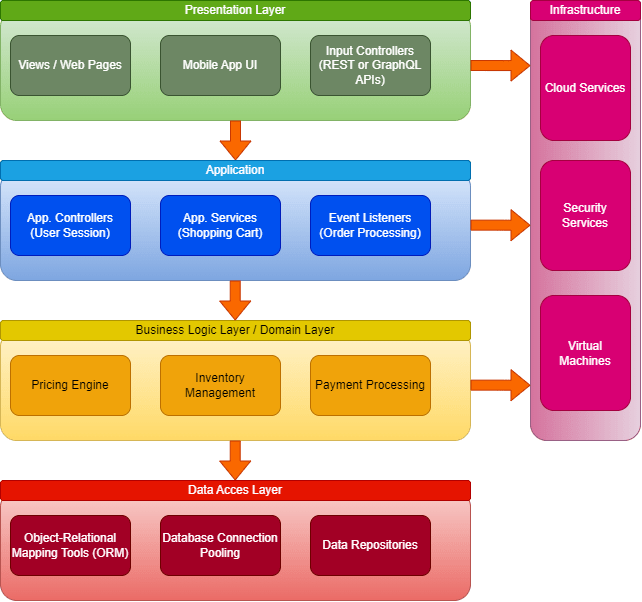Introduction
In the realm of software engineering, the layered architecture pattern is a popular method for designing applications. It organizes the application into a series of layers, each with a specific responsibility and role. This approach simplifies the development, maintenance, and scaling of applications. For our discussion, we’ll explore how to design a layered architecture for a generic e-commerce solution, detailing the transition from functional requirements to a fully organized architecture.
Understanding Layered Architecture
Layered architecture, also known as n-tier architecture, divides the application into a stack of layers with a specific function. This separation of concerns ensures that each layer interacts only with the layer directly below it, promoting a loose coupling and high cohesion within the application.
Design Process from Functional Requirements
- Gather Functional Requirements: The first step involves understanding the business needs. For an e-commerce solution, these might include user management, product browsing, order management, payment processing, and search functionality.
- Define the Layers: Based on these requirements, we define the layers of our architecture. Typically, an e-commerce application would include:
- Presentation Layer: The user interface and user experience components, including web pages and mobile app interfaces.
- Application Layer: The core functionality of the application, handling user requests, application logic, and user input validation.
- Business Logic Layer: The domain-specific logic for managing business rules, such as pricing calculations, discounts, and inventory management.
- Data Access Layer: The layer responsible for communicating with databases or other storage systems to retrieve and store data.
- Integration Layer: (Optional) For integrating with external services like payment gateways, email services, and third-party APIs.
- Organize Top Levels: The top levels (Presentation, Application, and Business Logic Layers) are designed to handle the flow of data and control through the application. They represent the frontend of the e-commerce solution, focusing on user interaction, application operations, and business processes.
- Design Lower Levels: The lower levels (Data Access and Integration Layers) represent the backend. These layers are crucial for data management and integration with external services. They ensure that data is correctly stored, retrieved, and communicated between the e-commerce application and other systems.
Example of Layered Diagramming:

Presentation Layer
The Presentation Layer is the user interface of the application, where interaction with the end-user occurs. It’s responsible for displaying information to the user and interpreting user commands.
- Web Pages: HTML, CSS, and JavaScript files that create the visual and interactive aspects of the e-commerce site.
- Mobile App UI: Components and screens designed for mobile devices, providing a responsive and tailored experience for users on smartphones and tablets.
- Web Services API Gateway: A single entry point for all client-side requests, facilitating interactions between the user interface and the application layer, often implemented using REST or GraphQL APIs.
Application Layer
The Application Layer coordinates the application’s operations, serving as an intermediary between the presentation layer and the business logic layer. It’s responsible for executing specific business rules and processes.
- User Session Management: Manages user sessions, including login, logout, and session timeouts, ensuring secure and efficient user experiences.
- Shopping Cart Management: Handles operations related to the shopping cart, such as adding or removing items, updating quantities, and calculating totals.
- Order Processing Workflow: Orchestrates the steps involved in placing an order, from order creation and validation to payment processing and confirmation.
Business Logic Layer
The Business Logic Layer encapsulates the core functionality of the system, implementing the business rules and policies of the e-commerce platform.
- Pricing Engine: Determines prices for products, including discounts, promotions, and dynamic pricing strategies based on various factors.
- Inventory Management: Keeps track of stock levels, manages reordering processes, and updates product availability in real-time.
- Payment Processing: Integrates with payment gateways to facilitate secure payment transactions, including credit card processing, refunds, and fraud detection.
Data Access Layer
The Data Access Layer provides abstracted access to the data storage mechanisms, ensuring that the business logic layer is decoupled from the data storage details.
- ORM (Object-Relational Mapping) Tools: Facilitates the mapping between objects in the application code and the relational database tables, simplifying data manipulation and queries.
- Database Connection Pooling: Manages a pool of database connections, optimizing resource utilization and improving application performance.
- Data Repositories: Implements the repository pattern to provide a clean separation and abstraction layer for accessing data sources, making the data operations more manageable and decoupled from the infrastructure concerns.
Infrastructure Layer
The Infrastructure Layer supports the entire application by providing the computing resources, networking, and foundational services required for its operation.
- Cloud Services and Virtual Machines: Hosts the application and its components, offering scalability, reliability, and geographic distribution.
- Security Services: Includes firewalls, intrusion detection systems, and encryption services to protect the application and its data against threats and vulnerabilities.
Conclusion
Designing a layered architecture for an e-commerce solution involves a detailed understanding of functional requirements and a systematic organization of the application into distinct layers. This architecture promotes scalability, maintainability, and the efficient development of complex applications.









